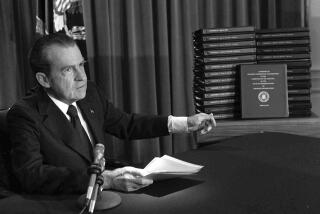Op-Ed: How to fix what ails Congress: bring back earmarks
- Share via
There are lots of complex proposals floating around for how to end partisan gridlock in Congress. But here’s a simple start: Bring back earmarked spending.
Earmarks — those legislative provisions that direct funding to specific projects — were banned by the House wholesale in 2011 in the name of reform. The Senate has been operating with an informal moratorium. House Speaker John A. Boehner (R-Ohio) is on the record as saying the ban on earmarks stays as long as he holds the gavel.
But congressional earmarks, done transparently, have their place in the legislative process.
Earmarks had been, admittedly, abused. They had increased in number and size through the 1990s and 2000s, and some House and Senate members used them to direct funds anonymously to questionable projects, a few of which weren’t remotely close to their districts. Most notoriously, former Rep. Randy “Duke” Cunningham (R-Rancho Santa Fe) pleaded guilty in 2005 to taking bribes to steer money to certain defense contractors and went to federal prison.
We’re not suggesting reverting to the old ways completely. Rather we believe that representatives and senators once again should be permitted to earmark federal spending for projects in their home district or state, so long as their name is publicly attached to that particular spending.
Earmark projects are not inherently wasteful. When we were in Congress, we both used them: Tom to fund repair of the Woodrow Wilson Bridge that extended from his district in northern Virginia to the Maryland suburbs, and Martin to build a light-rail system for his hometown of Dallas. We announced each of these projects proudly when they were funded.
If transparently attributed, and properly limited to one’s district, earmarks make great sense for a variety of reasons.
First, without them, Congress delegates the authority to allocate vast sums of discretionary federal spending to the executive branch. The president submits a budget at the beginning of each year and then Congress decides how much money each department and agency will get for its programs. But then someone in the federal bureaucracy decides which communities and states actually get those dollars. Earmarks reclaim a portion of that power for Congress.
A recent Brookings Institution analysis of federal discretionary spending that was published by Reuters demonstrated how the executive branch influences this distribution: Blue states benefit during a Democratic administration, and red states during in a Republican administration. (Swing states get special attention from both.) And yet even as Republicans in Congress are suing President Obama for overreaching his constitutional authority on immigration and healthcare, Congress has ceded its own authority over how federal dollars are spent by continuing the earmark ban. Go figure.
Second, eliminating earmarks takes away the incentive for the parties to cooperate to pass appropriations bills on time. Instead, for weeks and months after the start of each fiscal year on Oct. 1, much of the government is left operating on a continuing resolution. When a number of representatives and senators have “skin in the game,” they’ll make sure a spending bill gets passed.
Keep in mind, earmarks don’t add to the total spending by the federal government; they simply specify exactly how some of those allocated dollars must be spent. The appropriations process is a zero sum game, with or without earmarks. Even in 2010, when earmarks were supposedly out of control, they directed less than 1% of the federal budget.
Third, taking away earmarks removes nearly all the leverage that party leaders have to make Congress run. Already the two parties show little inclination to pass laws simply because they are in the national interest. Removing earmarks took one more arrow out of the party leaders’ quivers.
If party leaders and members themselves misuse this power, their party — and they personally — may well suffer the consequences at the polls in the next election. However, full public disclosure of who has earmarked what should keep everyone in the system honest.
Reforming congressional procedures is certainly an admirable objective. But the earmark ban has made it even harder for a basically dysfunctional Congress to operate at all.
Martin Frost represented a congressional district in Dallas-Fort Worth from 1979 to 2005. Tom Davis represented a district in the Virginia suburbs from 1995 to 2008. They two of the coauthors of the book “The Partisan Divide: Congress in Crisis.”
Follow the Opinion section on Twitter @latimesopinion and Facebook
More to Read
Sign up for Essential California
The most important California stories and recommendations in your inbox every morning.
You may occasionally receive promotional content from the Los Angeles Times.










